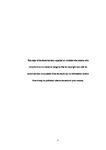Physiological, biochemical, and molecular responses to copper stress in different strains of the model brown alga Ectocarpus siliculosus
| dc.contributor.supervisor | Brown, Murray T. | |
| dc.contributor.author | Sáez Avaria, Claudio | |
| dc.contributor.other | School of Biological and Marine Sciences | en_US |
| dc.date.accessioned | 2014-05-13T12:56:30Z | |
| dc.date.available | 2014-05-13T12:56:30Z | |
| dc.date.issued | 2014 | |
| dc.date.issued | 2014 | |
| dc.identifier | 10313530 | en_US |
| dc.identifier.uri | http://hdl.handle.net/10026.1/3008 | |
| dc.description.abstract |
Brown algae have been the focus of metal ecotoxicology research for over 60 years, mainly because of their high metal accumulation capacity and reputed resistance. Now that Ectocarpus siliculosus has been positioned as a model for the study of brown algae, and that the genome has been recently sequenced and annotated, new lines of research have been made possible on these ecologically and economically important organisms, including the field of ecotoxicology. Several strains of E. siliculosus have been collected and isolated from locations around the world, thus providing the opportunity to study inter-population differences in their responses to environmental stress. This investigation can be split into three main sections. In the first part Cu exposure experiments were carried out under laboratory conditions using three strains of E. siliculosus: Es524 from a Cu polluted location in Chile, REP10-11 from a metal polluted (including Cu) location in England and LIA4A from a pristine site in Scotland. Strains were exposed for 10 d to concentrations ranging between 0 and 2.4 μM Cu. We measured different parameters: relative growth rates; metal accumulation (extracellular and intracellular); phytochelatins and the expression of related enzymes; oxidative stress responses as manifested in lipid peroxidation and levels of H2O2, and levels of pigments; levels of antioxidants glutathione and ascorbate (in reduced and oxidised forms), and phenolic compounds; and the activity of the antioxidant enzymes superoxide dismutase, catalase, and ascorbate peroxidise. Strain Es524 was the most efficient in counteracting the effects of Cu stress as manifested by a combination of Cu exclusion production of metal chelators, upregulation of oxidative enzymes, and strong antioxidant metabolism. REP10-11 also showed effective Cu defences, especially related to glutathione-ascorbate interactions. LIA4A was the least tolerant strain, with metabolic defences significantly less effective against Cu exposure. In part two a novel transplantation experiment was developed to compare responses in the field with those obtained in the laboratory. The study was carried out at a metal polluted and a low-impacted site in central Chile using strain Es524 (as in the laboratory experiments) and Es147, isolated from a low metal-polluted site in Chile. From the biomass, we conducted similar measurements of Reactive Oxygen Metabolism (ROM) as for the laboratory experiments described in the first part. In agreement with the laboratory experiments, strain Es524 displayed a higher resistance to metal stress. Because they behaved similarly between strains, the best suggested biomarker candidates for future assessments are metal accumulation, glutathione and ascorbate in reduced and oxidised forms, phenolic compounds, and the activity of superoxide dismutase. The method is simple, widely applicable in temperate environments, cost-effective, and provides a reliable representation of metal bioavailability in the environment. In the final part of the study a novel technique for the co-extraction of RNA and DNA, using a high pH Tris-HCl buffer, from small amounts of biomass of different strains of E. siliculosus was successfully developed. The extraction of nucleic acids from brown algae is considered to be difficult and the product is of poor quality due to the high concentrations of interfering secondary metabolites such as phenolics and polysaccharides. The protocol devised here provided high yields of pure RNA and DNA that are suitable for molecular analyses. This investigation provides new insights on metal stress metabolism in brown algae, and demonstrates that metal resistance is dependent on inherited defences developed over a long history of exposure. Furthermore, the good agreement between the results obtained in the laboratory with those from the field study confirms that the responses expressed under controlled laboratory conditions are representative of stress metabolism of E. siliculosus under natural conditions. | en_US |
| dc.description.sponsorship | Comisión Nacional de Investigación Científica y Tecnológica (CONICYT), Becas Chile Nº72110557 | en_US |
| dc.language.iso | en | en_US |
| dc.publisher | Plymouth University | en_US |
| dc.subject | Algae | |
| dc.subject | Reactive oxygen | |
| dc.subject | Chelators | |
| dc.subject | Gene expression | |
| dc.subject | Biomonitoring | |
| dc.subject | Biomarkers | |
| dc.subject | Metal | en_US |
| dc.title | Physiological, biochemical, and molecular responses to copper stress in different strains of the model brown alga Ectocarpus siliculosus | en_US |
| dc.type | Thesis | |
| plymouth.version | Full version | en_US |
| dc.identifier.doi | http://dx.doi.org/10.24382/3467 |
Files in this item
This item appears in the following Collection(s)
-
01 Research Theses Main Collection
Research Theses Main


